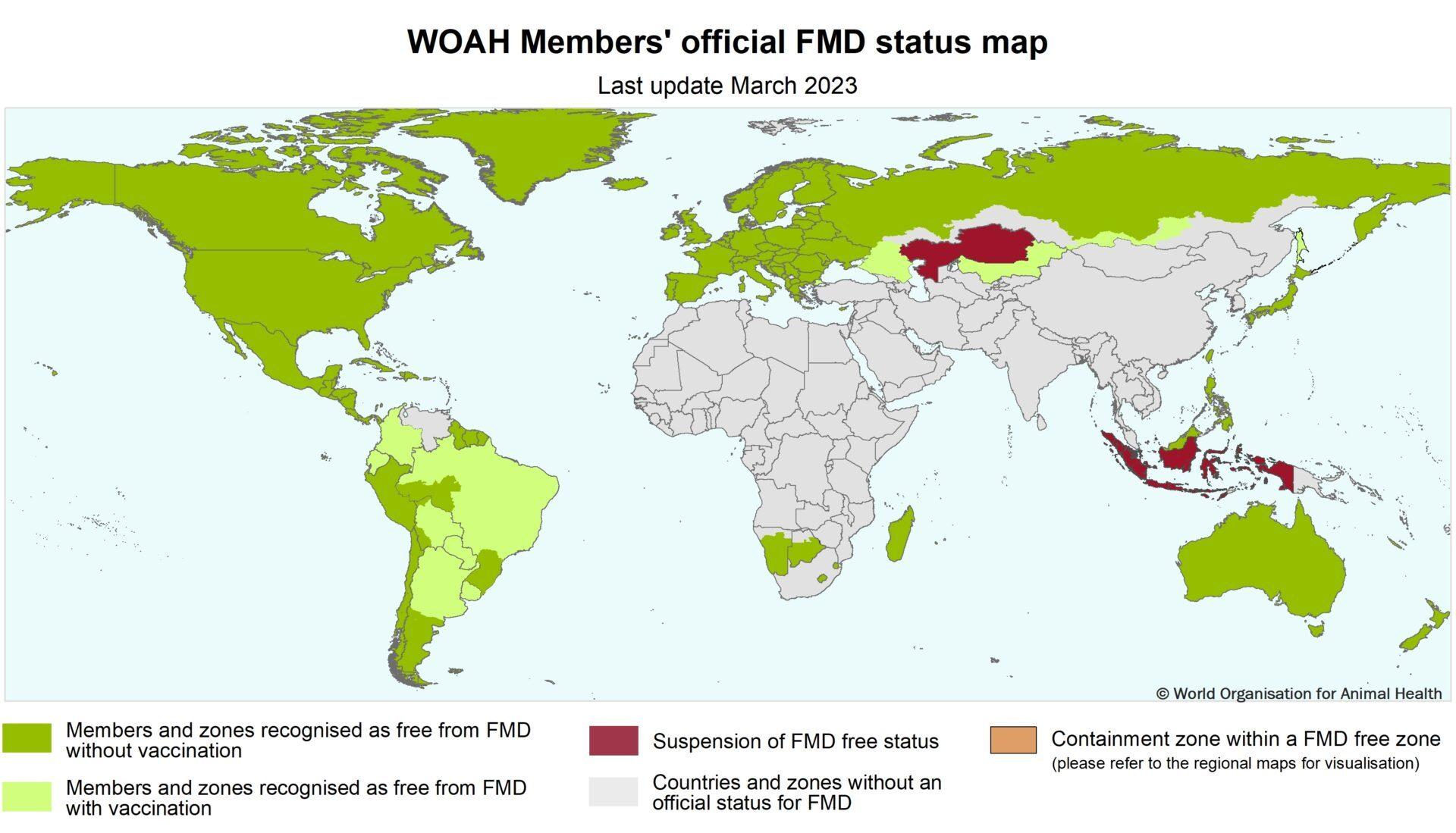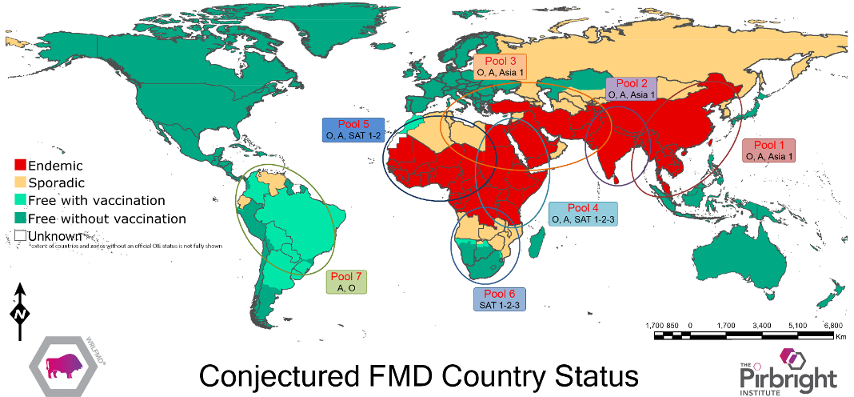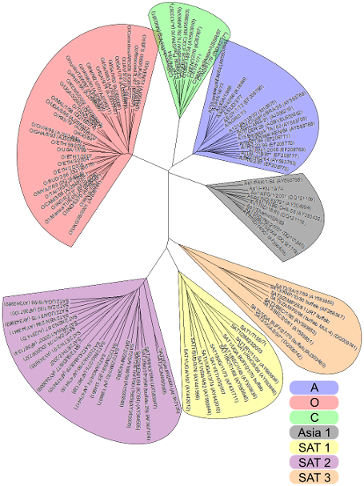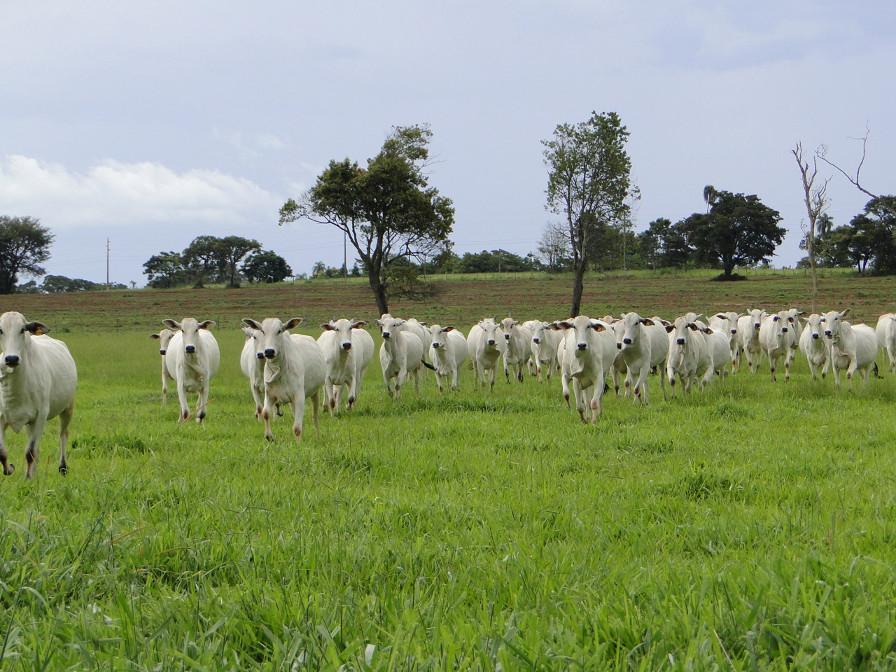Current global status of Foot-and-Mouth Disease
WOAH member states' Official FMD status
List of WOAH Member Countries officially recognised free from Foot-and-Mouth Disease (FMD) by the WOAH.

WRLFMD conjectured FMD status and regional pools
Distribution of the seven endemic pools of Foot-and-Mouth Disease showing conjectured status of FMD in countries during 2015.

About Foot-and-Mouth Disease
Foot-and-Mouth Disease affects domesticated and wild, cloven-footed animals. It was first shown to be caused by a virus (Foot-and-mouth disease virus, FMDV) in 1897.
Foot-and-Mouth Disease occurs in many parts of the world and especially in developing countries and in Africa and Asia. Some countries have been FMD-free for many years. North America, most European countries, Australia, New Zealand and many island states are recognised as being FMD-free. The disease has almost been eradicated in South America and eradication is underway in China and India.
WOAH map of official FMD status
As Foot-and-mouth disease is a globally distributed disease it is refered to in many different languages. A collection of the different names for the disease in different languages has been made and is available on this site.
FMD in different languages
After infection with Foot-and-mouth disease virus, there is an incubation period which usually lasts a few days, but occasionally up to two weeks. Then there is a fever associated with general illness and in cows with a marked decline in milk production. Soon after, blisters appear on the feet and in the mouth. Blistering in the mouth may cause stringy or foamy saliva and drooling, while foot blisters may cause lameness. Blisters rupture to form erosions that heal over a period of weeks. Disease severity varies according to species, breed and pre-existing immunity. Subclinical infection is common in small ruminants.
Myocarditis is possible in young animals and this can be associated with sudden death.
WOAH Technical Disease Card for Foot-and-Mouth Disease
Foot-and-Mouth Disease is highly contagious and can be spread from animal to animal by close contact or by aerosols. Transmission can also occur via products including meat and milk from infected animals and through contact with contaminated objects (such as farm equipment, vehicles, clothes and feed).
There is no specific treatment for Foot-and-Mouth Disease but provision of adequate drinking water and prevention of mastitis and fly strike all improve recovery, especially for dairy cattle which can be severely affected by the disease.
Control may be possible by vaccination, animal movement control/quarantine and destruction of infected animals. Biosecurity and disinfection are also important in blocking spread. Vaccination is hampered by the antigenic diversity of the virus, the short-lived nature of protective immunity and the thermal instability of FMD vaccines.
There are at 7 different varieties (serotypes) of FMDV, named: Serotypes O, A, C, O, Asia 1, SAT 1, SAT 2 and SAT 3. All give rise to a similar disease.
The global distribution of these serotypes is not even:
- Serotypes A and O can be found in most FMD endemic regions, with the exception of southern Africa;
- The Asia 1 serotype can be found in the FMD endemic regions of Asia;
- The African buffalo is the natural host for the Southern African Territoryies (SAT) serotypes. SerotpyesSerotypes SAT 1 and SAT 2 can be found throughout Africa, while SAT 3 is limited to southern and a small area in eastern Africa;
- FMDV serotype C has not been detected since 2004 (in Kenya and Brazil), so it is possible that this serotype is no longer circulating.
Genetic relationship between FMDV serotypes

(click on the picture to open a large version in a new window).
Genetic relationship (using VP1 sequences) between FMDV serotypes. The prototype strain sequences used to create this phylogenetic tree are available on www.wrlfmd.org
Global conjectured FMD status

(click on the map to open a large version in a new window).
Distribution of the seven endemic pools of Foot-and-Mouth Disease showing conjectured status of Foot-and-Mouth Disease in countries during 2015. Virus circulation and evolution within these regional virus pools results in changing priorities for appropriately adapted vaccines. Periodically, viruses spread between pools and to free regions, and countries at the interfaces between pools (such as in North Africa and Central Asia) often experience FMD outbreaks from different regional sources. Note on Pools 4-6: In Africa there are currently three FMD virus pools loosely defined as covering East Africa (pool 4), West Africa (pool 5) and Southern Africa (pool 6). There is some overlap between pools 4 and 5. It has been suggested to extend pool 4 southwards to include Tanzania and to contract pool 6 to exclude that country (© WRLFMD).

